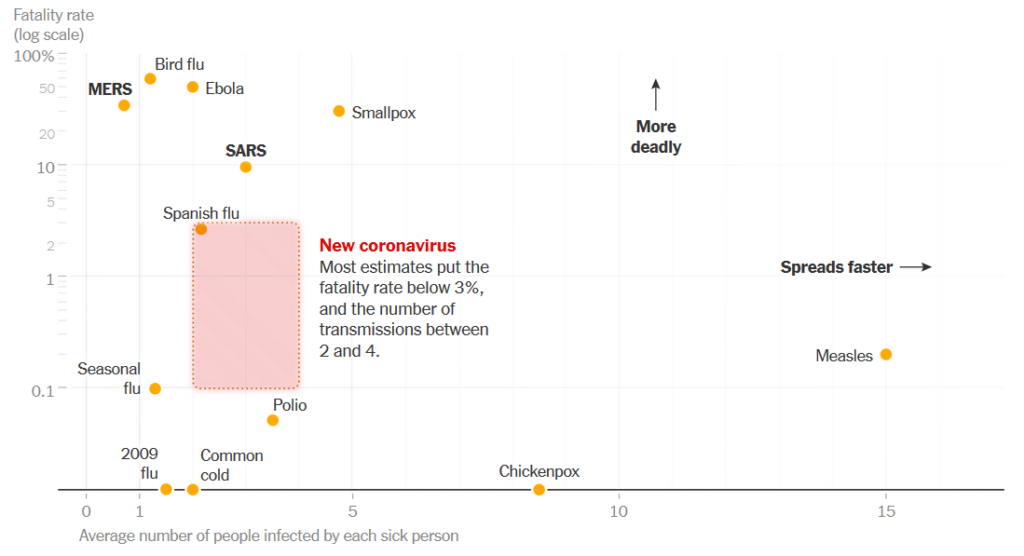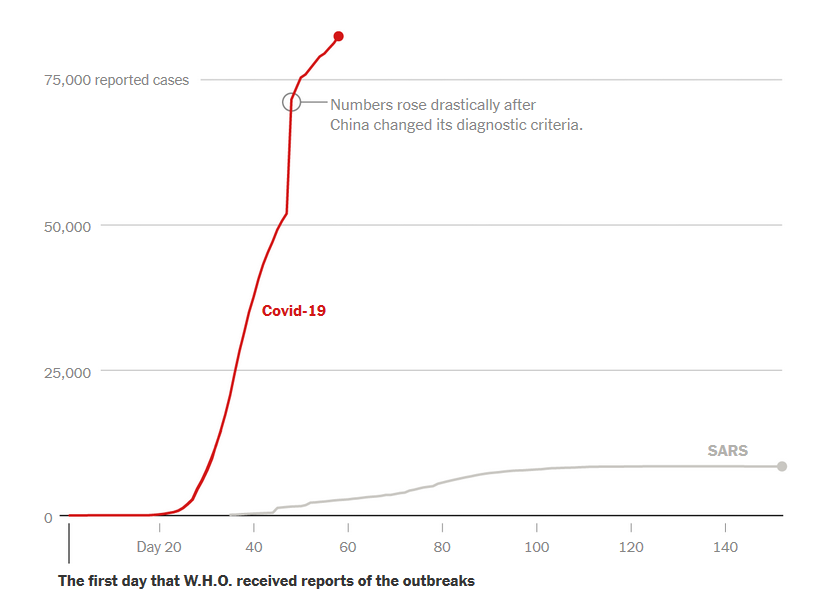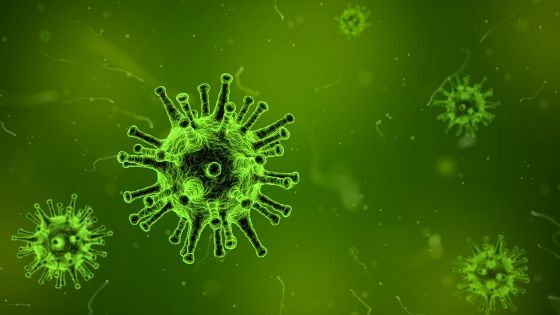7 Last Minute Coronavirus Prepping Tips
Coronavirus has arrived to the US, and the window for planning and preparing has closed. The Emergency Support Functions (ESF-8) have been activated, and a task force has been assigned. We are already in phase 3 of the Four Phases of Emergency Management: Response.
What does this mean for late preppers still getting ready for a pandemic? Stock resources are already low. Supply chains are being actively disrupted. Financial markets are experiencing an early shock. Most importantly: the infections have spread across borders and people are dying. Despite the grim appearance of the situation, there is no need to panic. There are plenty of actions you can take to improve your personal preparedness.
The Last Minute Tips
- Stay Informed
- Understand the Risk
- Finding Resources When They Are Scarce
- Be Vigilant for Scams
- The Importance of Hygiene
- Prompt Employers, Institutions, Schools
- Create a Basic Emergency Plan
1/7 Stay Informed
During any emergency, you need to make it a priority to stay informed. Luckily, for pandemics, traditional communication outlets: TV, internet, and phone service typically continue to function. It is just up to you to find correct information.
The CDC (Centers for Disease Control and Prevention), NIH (National Institutes of Health), and WHO (World Health Organization) are great sources that update regularly with officially vetted news and updates.
- CDC Coronavirus Disease 2019 (COVID-19) Dashboard
- NIH Coronavirus (COVID-19) Situation Summary
- WHO novel coronavirus (COVID-19) Summary and News
China has a history of under-reporting the severity of epidemics and pandemics originating in their region.
Reports and counts originating from China and some other regions may be under-reported depending on their detection capability and political factors.
Facebook, Twitter, and online forums are not the best sources of information if reputable sources are not given. Videos are already being shared out of context, statistics are being fabricated, and opinions are being shared as fact. During a pandemic, an understanding of risk is very important- and it can be dangerous to understate or overstate the situation.
2/7 Understand the Risk
We are learning new things about the novel coronavirus 2019 outbreak every day, through research advancements, statistical updates, and observed patterns in the virus transmission.
The Data
Mortality rates and infection rates seem to indicate that COVID-19 settles somewhere between SARS and Seasonal Flu, according to graphs like this. The initial graph had the transmission rate much lower and did not include the Spanish Flu comparison. Now they have shifted the window up and to the right (not the direction we want it to go):

The infection window in the graph above is accurate to WHO, CDC, and NIH projections for the virus, but it does not align with the infection count. This can be seen when you compare reported cases from COVID-19 to SARS:

So how is the infection rate not capturing the risk, and why is it spreading so much faster than SARS did?
The long incubation period of the virus has made it difficult to detect in the world. People are going days without exhibiting any symptoms, which can allow contact with many more people than a virus with a rapid onset of symptoms. There have also been instances of patients gaining medical clearance, and then testing positive for coronavirus a second time.
The coronavirus has proven to be more elusive than many of its predecessors, making it difficult to test for, contain, and quarantine.
Who’s at Risk?
Every demographic has been susceptible to coronavirus so far, yet there is a population that is being disproportionately affected:
Older Males
The statistics show that most mortalities from coronavirus are occurring in this demographic:
- The median age of people who have died is 75 (Source: NIH)
- Males within this range are dying at 3 times the rate of females (Source: NIH)
The statistics may even out as more mortalities are reported, but these initial reports show that there is a demographic that should take extra precautions as this virus spreads.
Luckily, some demographics are proving to be very resilient to the disease. Children are reported as having very mild symptoms, which can be comforting to parents. Still, the outbreak is still young and it is important for everyone to be prepared, remain vigilant, and prioritize their health and safety.
3/7 Finding Resources When They Are Scarce
If you are looking for hand sanitizer, N95 masks, or prepackaged long-term food storage… you may have noticed that shelves are getting empty. Wal-Marts, Sam’s Clubs, and Lowe’s have empty shelves where these used to stand.
Supply chain interruptions have caused some issues, with N95 mask shortages emerging in the news. Mountain House, one of the main dehydrated food vendors, is running low on almost all of their buckets. They still have a few pouches and #10 cans available. Legacy Food Storage is stating that their shipping window has been extended to 30-50 days from the order.
One of the easiest ways to get around shortages is by using substituted products. Respirators and gas masks are not sold out (yet), and give you a solution to an even wider range of emergency and disaster events in the future. Canned goods are cheap and abundant still, letting you stock your pantry quickly at a local grocery store.
You may see mixed messaging on this from health leaders because while they want the public to be prepared, they also do not want a panic rush on all pandemic-related equipment and emergency supplies.
4/7 Be Vigilant for Scams
Emergencies and resource shortages can bring out the scumbags in our society. People have already started to resell and price gouge face masks and other emergency supplies. They will also start to peddle dangerously ineffective supplies.
Price Gouging
Amazon is combating price gouging on its website, but they do not appear to be doing so successfully. You can also see people on eBay or Facebook marketplace reselling emergency supplies at over 500% markups.
N95 masks have been the first hit hard, with shortages reported through civilian retail outlets. Emergency food is also in short supply, so you may find these are more expensive if you are not buying direct.
Ineffective Supplies
Mislabeled supplies have already started cropping up. N95 masks are masks that achieve a specific rating through NIOSH testing- it’s not just an arbitrary name.
Some sellers seem confused by this, listing NON-N95 masks for sale labeled with the NIOSH rating. Simple cloth masks with designs on the front and crocheted masks would have a tough time getting this rating.

Once the virus is more widespread, there may also be specialty treatments peddled with high markups. You may have noticed the similarities so far between the movie Contagion and the COVID-19 outbreak. In the movie, Jude Law’s character pushes an over-the-counter remedy without any scientific backing (and makes some money doing it).
Scams like this have already started to emerge, but not yet to the magnitude shown in the movie:
Jude Law’s character may seem like he is trying to help throughout the movie, but is exposed for the opportunist he is at the end.
5/7 The Importance of Hygiene
Social distancing is the preferred method of reducing your risk for pandemics. This means that you are not placing yourself in close proximity to others, especially in crowded areas where the disease could rapidly spread. A close second to social distancing is good hygiene.
People often underestimate the impact hygiene can have early on during pandemics. Testing is scarce and symptoms are not severe for many in the population. The potential for the virus to spread into areas before they are aware is high. To reduce your risk of contracting the coronavirus – or any virus for that matter- you should be practicing good hygiene.
Hand Washing
At this point, you’ve seen us preach about hand washing a lot. Many people do not properly wash their hands and ‘go through the motions’ rather than paying attention to getting their hands clean.
Face Touching
Avoid touching your face. It’s harder than it sounds: many bad habits involve touching your face with your hands. Smoking, biting nails, nervous ticks- all of these can make it tough for your immune system by introducing viruses and bacteria.
It is very tough to break a habit, but it doesn’t hurt to try. This is an important priority with a pandemic looming, so it is a great time to kick these habits. Check out some more habits you should consider kicking:
11 Common Bad Habits Every Prepper Needs to Break
Shaving
Respirators, N95 Masks, and even gas masks have a difficult time creating a seal with a hairy face. Even a few days stubble can interfere with a mask’s seal.
There are a few creative ways to get around this with a gas mask, but the best way is to just shave your beard.

The graphic above makes it easy to see if you can make a beard style work with a respirator, N95 mask, or gas mask. Very few beards work: most of the green check marks are variations of mustaches.
6/7 Prompt Employers, Institutions, Schools
The CDC, the President of the USA, and all other top-level officials actually agree on one thing: employers, institutions, and schools should be preparing for the coronavirus. Many employers, institutions, and schools are instead dragging their feet. If you are involved at any business, school, daycare, college, or government agency- you may be able to prod them in the right direction.
Many plans and procedures have been ‘gathering dust’- as the head of the NIH stated. It’s time to get them out and dust them off. Coronavirus is not an exercise or something to be shrugged off as an impossibility. It may seem far from home, but it is guaranteed to get closer, if not arrive on your doorstep.

It doesn’t hurt to ask your HR department what the plan is for coronavirus. Many are making plans to allow telecommuting if the job will allow for it. Schools, preschools, daycares, and other school-age programs will be considering cancellations as we have seen in other countries with outbreaks. You need to be working with your employer to make sure your bases are covered, and that you can care for your children without a threat to your employment status if the need arises.
7/7 Create a Basic Emergency Plan
It’s never too late to start prepping… until it’s too late. But that time isn’t here yet- and you can begin with a simple emergency plan.
Why do you need an Emergency Plan?
Because everyone needs an emergency plan. And they aren’t just for coronavirus. Things aren’t always sunshine and roses in life, and the more prepared you are for those times the less of an impact they can have on your future. We’re not talking about building bunkers for a dystopian apocalyptic scenario- this plan is for everything from small emergencies to – you guessed it- pandemics.
An emergency plan is just a plan you put in writing that helps you and your family navigate emergencies. Half of the help a plan provides is just getting you and your family sitting down and talking about situations that could occur, dispelling fears, and setting rules and responsibilities.
Gathering up your family and talking about what they have heard about coronavirus and what the facts are could be very helpful.
Writing the plan down helps you reference it in an emergency, but also helps you remember what you wrote and be intentional in your planning specifics.
We’ve done all the hard work for you and have a basic emergency plan template available here:
The Basic Emergency Plan – The Foundation of Preparedness
Use this plan to set your expectations for all emergencies, not just coronavirus.
The Final Word
I hope these tips helped you understand the coronavirus better and will help you be better prepared for a pandemic. The outbreak has started and it is not too late to start prepping.
For more reading, I suggest you check out:
- When Does a Flu Become a Pandemic?
- How the Next Pandemic Will be Like the Powerball
- The Spanish Flu – The 100-Year Anniversary
- The Ultimate Gas Mask Guide for Preppers
Keep exploring, stay prepared, and be safe.
You’ve Been Missing Out
Join the 2+ million preppers that rely on our prepping advice by subscribing to TruePrepper.- Practical guides and tips
- Useful survival giveaways
- Free, forever
- < 0.4% of people unsubscribe



Thank you! These tips were very helpful.